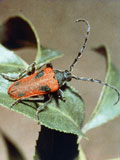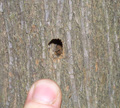Animal
Conservation Projects
Population
Dynamics and Conservation of Tricolored Blackbirds, Agelaius tricolor
I am interested in the population dynamics and conservation of
Tricolored Blackbirds. Tricolored Blackbirds are the most colonial songbird
in North America, and represent a conservation challenge because of their
itinerant breeding and use of multiple habitats. The species is largely
endemic to California (>99% of birds) with small populations in adjacent
states and Baja California. The species is of conservation concern because populations
have declined in abundance by an estimated 89% between the 1930’s and 1980’s.
California experienced dramatic wetland losses, with a 91% loss between 1780
and 1980. Wetland loss and fragmentation are cited as the principle reasons
for decline. Yet, the species has also shifted the kinds of habitat used for
breeding, making it hard to know the role of shifts in habitat type in
observed declines. My lab has worked with collaborators to analyze population
trends, look at habitat usage and how habitat use varies with factors like
rainfall. The species has also advanced its breeding by an average of 22 days
between 1939 and 2009, which likely is an effect of climate change. The work is funded by California Department
of Fish and Game. The Tricolored
Blackbird Portal was populated with historical data by my lab and
provides more information about the species. Collaborators includes Rodd Kelsey, Audubon California rkelsey at
audubon.org Bob Meese, Information Center for the Environment at UC-Davis, http://ice.ucdavis.edu/people/rjmeese, rjmeese at ucdavis.edu Emilie Graves, Wildlife, Fish and Conservation Biology at
UC-Davis, eegraves
at ucdavis.edu. Conservation
of a threatened beetle
|
Male
Tricolored Blackbird @ Marcel Holyoak. |
||
|
A major
research direction is the spatial dynamics of a threatened insect, the Valley
Elderberry Longhorn Beetle, Desmocerus californicus dimorphus. For further
information about the beetle see Theresa Talley's website: http://web.mac.com/tsinicrope/iWeb/Site/VELB%20info/VELB%20info.html Field
surveys were used to investigate the importance of different spatial scales
for the persistence of this federally protected species, which is restricted
to riparian habitats in California’s Central Valley. This project, in
collaboration with Dr.
Sharon K. Collinge (U. of Colorado), Jaymee T.
Marty and Cheryl B. Barr (Essig Museum of Entomology,
UC-Berkeley) demonstrated that local populations showed frequent turnover.
However, at the watershed scale there was no extinction or colonization over
10 years (Collinge
et al. 2001). Isolated sites were less likely to be occupied by the
beetle. This is valuable information because it suggests that a
watershed-scale approach is necessary for successful conservation. More recent work in collaboration with my Ph.D. student Theresa
Talley investigated the relationship between the beetle and its host plant,
elderberry, which needs to reach a minimum size (and age) before being
suitable for the beetle. When habitat is destroyed and new habitat is planted
through mitigation there is a time period before the habitat becomes
suitable; this ‘lag time’ means that even when habitat losses are
well-mitigated there is a temporally substantial loss of habitat that could
destabilize populations. We used habitat restoration, mitigation and natural
sites to explore site age, the amount of suitable beetle habitat available
and how this influences population presence and abundance. This project
yielded both practical information about mitigation and habitat restoration
practices and useful ecological information about a species which is puzzling
because it persists at low densities. The results aid conservation by
providing a scientific backing for conservation and management decisions. Current and
Past Collaborators on this work include: Theresa Talley, University of San Diego tstalley
AT ucsd.edu Gary Huxel, University of Arkansas ghuxel AT uark.edu Sharon K. Collinge, University of Colorado Sharon.Collinge AT Colorado.edu |
Adult
beetles are approximately 2 cm (3/4") long and are rarely seen.
The
beetle feeds only on a single plant species, elderberry (Sambucus
spp.).
Beetles
spend most of their lives burrowing inside elderberry stems. They leave distinctive
emergence holes of 6-10mm diamteter. |



